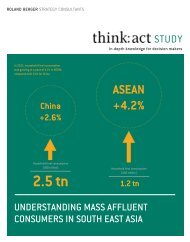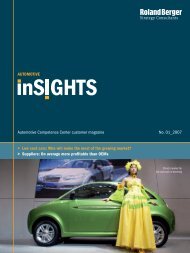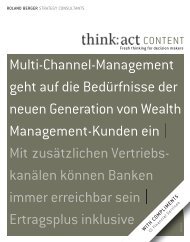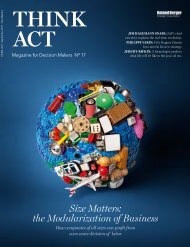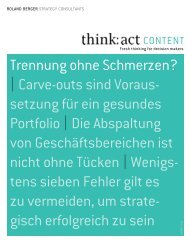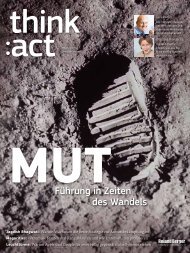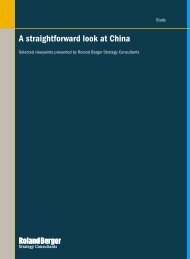Chinese Consumer Report 2012 - Luxury - Roland Berger
Chinese Consumer Report 2012 - Luxury - Roland Berger
Chinese Consumer Report 2012 - Luxury - Roland Berger
You also want an ePaper? Increase the reach of your titles
YUMPU automatically turns print PDFs into web optimized ePapers that Google loves.
Defining <strong>Chinese</strong> luxury brand consumers<br />
The capacity and increasing speed of the global luxury market<br />
[One billion euros]<br />
Other countries<br />
Other Asia-Pacific<br />
countries<br />
Japan<br />
<strong>Chinese</strong> mainland<br />
America<br />
Europe<br />
Who are <strong>Chinese</strong> luxury brand consumers?<br />
CAGR<br />
New market<br />
capacity<br />
New market<br />
proportion<br />
Source: <strong>Roland</strong> <strong>Berger</strong> Analysis<br />
Gender distribution Age distribution Household income distribution<br />
<strong>Chinese</strong> consumers are displaying a newfound<br />
and growing interest in luxury goods. The<br />
wealthy and elite are eagerly embracing the<br />
culture of the luxury market and wish to own<br />
the same brands that are popular in developed<br />
economies. This has not escaped the notice of<br />
mainstream luxury brand producers. In recent<br />
years they have seen their products become<br />
a feature of daily life in China to a moderate<br />
but steadily increasing degree. If luxury goods<br />
makers are to capitalize on this trend they<br />
should move quickly to acquire and develop<br />
a deeper understanding of <strong>Chinese</strong> luxury<br />
consumers. As <strong>Chinese</strong> luxury consumers are<br />
expected to account for 40% of the new luxury<br />
market globally between 2010- 2015, it is an<br />
opportunity that few can afford to miss.<br />
Male<br />
Female<br />
China<br />
Source: 2011 <strong>Roland</strong> <strong>Berger</strong>’s <strong>Chinese</strong> <strong>Luxury</strong> <strong>Consumer</strong>s Survey (n=1,393), Germany 2010 Survey; <strong>Roland</strong> <strong>Berger</strong> analysis<br />
Archetypes of <strong>Chinese</strong> luxury consumers<br />
Archetypes:<br />
Western<br />
European<br />
<strong>Consumer</strong>s<br />
Era leader<br />
Wealthy second<br />
generation<br />
Western<br />
European<br />
<strong>Consumer</strong>s<br />
China<br />
highest<br />
20%<br />
medium<br />
30%<br />
lowest<br />
50%<br />
Ambitious elites Savvy investors<br />
Western<br />
European<br />
<strong>Consumer</strong>s<br />
Stylish whitecollars<br />
China<br />
Gift buyers<br />
Buyers of luxury goods in China are younger<br />
than buyers in mature markets. This can<br />
be attributed to a large degree to China's<br />
demography. China has a relatively young<br />
age population and wealth creation has been<br />
mostly concentrated in the young generation<br />
since the country's social and economic<br />
reform. A further differentiating factor,<br />
however, is that <strong>Chinese</strong> luxury consumers are<br />
often found in the top social status group as<br />
opposed to the more general across-the-board<br />
distribution that occurs in mature markets.<br />
Archetypes<br />
% Share ~25% ~30% ~10% ~5% ~10% ~20%<br />
Social profile<br />
Psychological<br />
traits<br />
Behavioral<br />
traits<br />
> private business<br />
owners, corporate<br />
executives<br />
(foreign, stateowned,<br />
private)<br />
> 25 to 40 years<br />
old<br />
Pursue<br />
>worship<br />
>wisdom<br />
>self-cultivation<br />
>follow others<br />
> recognize top<br />
brands<br />
> young people<br />
from the second<br />
generation of<br />
the wealthy<br />
and officials,<br />
including “rich<br />
men’s wives”<br />
> 20 to 35 years<br />
old<br />
Pursue<br />
>innovation<br />
>self-confidence<br />
>passion<br />
> are independent<br />
> have strong selfawareness<br />
> middle managers<br />
of multinational<br />
or state-owned<br />
companies,<br />
professionals,<br />
entrepreneurs<br />
> 25 to 35 years<br />
old<br />
Pursue<br />
>enterprise<br />
>passion<br />
>challenge<br />
> have strong selfawareness<br />
> have a good<br />
understanding of<br />
luxury goods<br />
> real estate<br />
speculators,<br />
stock traders,<br />
freelancers, the<br />
unemployed<br />
> 25 to 40 years<br />
old<br />
Pursue<br />
>trendiness<br />
>individuality<br />
>luxury<br />
> have fluctuating<br />
consumption<br />
capacity<br />
> focus on<br />
popularity<br />
> fresh to the<br />
workforce, have<br />
stable income<br />
higher than their<br />
peers<br />
> 20 to 30 years<br />
old<br />
Pursue<br />
>beauty<br />
>luxury<br />
>fashion<br />
> have strong selfawareness<br />
> have a good<br />
understanding of<br />
luxury goods<br />
> lack of distinctive<br />
features<br />
Pursue<br />
>worship<br />
>respect<br />
> have a low<br />
purchasing<br />
frequency<br />
> focus on<br />
popularity<br />
<strong>Roland</strong> <strong>Berger</strong> experts segmented <strong>Chinese</strong><br />
luxury consumers into six archetypes<br />
based on their physical, psychological and<br />
behavioral characteristics. The six archetypes<br />
are Era Leaders, Wealthy Second Generation,<br />
Ambitious Elites, Savvy Investors, Stylish<br />
White Collars and Gift Buyers. An in-depth<br />
appreciation of the uniqueness of these six<br />
groups can assist producers of luxury brands<br />
to devise more precise brand development<br />
strategies for the <strong>Chinese</strong> market.<br />
Source: 2011 <strong>Roland</strong> <strong>Berger</strong>’s <strong>Chinese</strong> <strong>Luxury</strong> <strong>Consumer</strong>s Survey (n=1,393), industry interviews; <strong>Roland</strong> <strong>Berger</strong> analysis<br />
4



